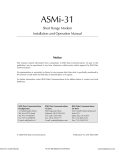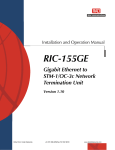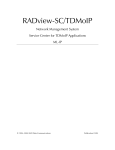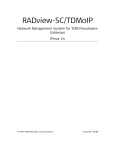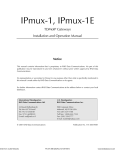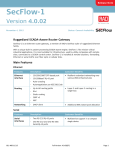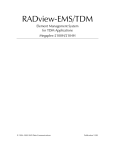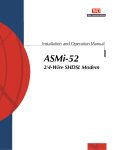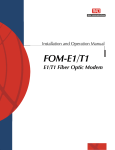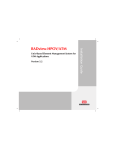Download MEGAPLEX-2100 MODULE
Transcript
Order from: Cutter Networks Installation and Operation Manual VC-6 6-Channel PCM Voice Module MEGAPLEX-2100 MODULE Ph:727-398-5252/Fax:727-397-9610 www.bestdatasource.com MEGAPLEX-2100 MODULE VC-6 6-Channel PCM Voice Module Installation and Operation Manual Notice This manual contains information that is proprietary to RAD Data Communications. No part of this publication may be reproduced in any form whatsoever without prior written approval by RAD Data Communications. No representation or warranties for fitness for any purpose other than what is specifically mentioned in this manual is made either by RAD Data Communications or its agents. For further information contact RAD Data Communications at the address below or contact your local distributor. International Headquarters RAD Data Communications Ltd. U.S. Headquarters RAD Data Communications Inc. 24 Raoul Wallenberg St. Tel Aviv 69719 Israel Tel: 972-3-6458181 Fax: 972-3-6498250 E-mail: [email protected] 900 Corporate Drive Mahwah, NJ 07430 USA Tel: (201) 529-1100 Toll free: 1-800-444-7234 Fax: (201) 529-5777 E-mail: [email protected] © 2000 RAD Data Communications Order from: Cutter Networks Ph:727-398-5252/Fax:727-397-9610 Publication No. 764-224-09/00 www.bestdatasource.com Quick Start Guide If you are familiar with the VC-6 module, use this guide to prepare it for operation. Preliminary Preparations VC-6/FXS and VC-6/FXO modules do not require any internal settings. For VC-6/E&M modules, select the required signaling mode referring to figure below. Type I Type II Type III SSDC5 SW1 ON ON ON OFF SW2 SW3 ON ON OFF ON ON ON OFF OFF ON SW1 SW2 OFF SW3 Connecting the Cables Order from: Cutter Networks Insert the VC-6 module in the assigned slot of the Megaplex enclosure and then connect voice channels as follows: • VC-6/E&M modules – use an adapter cable to connect the voice channels to the module TELCO connector. • VC-6/FXS and VC-6/FXO modules – connect the voice channels directly to the module RJ-11 connectors. Connect the -48 VDC external feed voltage, if required. 1 Ph:727-398-5252/Fax:727-397-9610 www.bestdatasource.com VC-6 Installation and Operation Manual Quick Start Guide Configuring the Module Configure the VC-6 module and channel parameters, and assign a main link timeslot to each connected channel. The configuration parameters and the allowed range of values are listed below. Parameter Range of Values Module Parameters WIRES NUM 4-WIRES 2-WIRES CODING a LAW u LAW SIGNALING T1 Links: RBMF SIGNALING ROBBED BIT FRAME NO SIGNALING E1 Links: CAS RBMF SIGNALING ROBBED BIT FRAME NO SIGNALING PROFILE 1 2 OUT-OF-SERVICE IDLE-BUSY BUSY-IDLE FORCED-IDLE FORCED-BUSY TDM LINK Channel Parameters CONNECT YES NO TRANSMIT LEVEL VC-6/E&M +8 dBm to -17 dBm VC-6/FXS +8 dBm to -13 dBm VC-6/FXO +7 dBm to -18 dBm RECEIVE LEVEL VC-6/E&M +2 dBm to -23 dBm VC-6/FXS +2 dBm to -17 dBm VC-6/FXO +2 dBm to -23 dBm OPERATION MODE BIDIRECTIONAL UNIDIRECTIONAL BROADCAST 2 Order from: Cutter Networks Ph:727-398-5252/Fax:727-397-9610 www.bestdatasource.com Contents Chapter 1. Introduction 1.1 Overview .......................................................................................................... 1-1 Versions...................................................................................................................1-1 VC-6/E&M Modules.................................................................................................1-2 VC-6/FXS and VC-6/FXO Modules ...........................................................................1-3 1.2 Physical Description .......................................................................................... 1-6 1.3 Functional Description ...................................................................................... 1-7 Audio Performance..................................................................................................1-7 Support for Unidirectional and Broadcast Applications .............................................1-7 Handling Of Signaling Information .........................................................................1-10 Timeslot Assignment ..............................................................................................1-13 Management .........................................................................................................1-13 Test and Diagnostic Capabilities .............................................................................1-13 1.4 Technical Specifications .................................................................................. 1-14 Chapter 2. Module Installation and Setup 2.1 General............................................................................................................. 2-1 2.2 Module Setup ................................................................................................... 2-1 VC-6/E&M ...............................................................................................................2-1 2.3 Module Installation ........................................................................................... 2-4 Connecting the Voice Channels ...............................................................................2-4 Connecting the External -48 VDC Voltage ................................................................2-4 2.4 Normal Indications............................................................................................ 2-5 Chapter 3. Configuration Instructions 3.1 Configuring VC-6 Module ................................................................................. 3-1 Configuring Module Parameters ...............................................................................3-1 Configuring Channel Parameters ..............................................................................3-3 Assigning the Timeslots ............................................................................................3-4 Chapter 4. Alarms and Diagnostics 4.1 General............................................................................................................. 4-1 4.2 Alarm Messages................................................................................................. 4-1 4.3 Diagnostics........................................................................................................ 4-2 Local Loop...............................................................................................................4-2 Remote Loop...........................................................................................................4-3 Tone Injection .........................................................................................................4-4 4.4 Troubleshooting Instructions ............................................................................. 4-5 Recommended Test Sequence .................................................................................4-5 Appendix A. Connector Data A.1 VC-6/E&M Connector .......................................................................................A-1 A.2 VC-6/FXS and VC-6/FXO Connector..................................................................A-2 A.3 DC POWER IN Connector ................................................................................A-2 Appendix B. Operation with FCD-E1M and FCD-T1M B.1 Configuration Parameters .................................................................................. B-1 B.2 Alarm Messages................................................................................................. B-2 VC-6 Installation and Operation Manual Order from: Cutter Networks i Ph:727-398-5252/Fax:727-397-9610 www.bestdatasource.com Table of Contents List of Figures 1-1. 1-2. 1-3. 1-4. 1-5. 1-6. 1-7. Typical Basic Application for VC-6/E&M Modules...................................................... 1-2 Typical OPX Application for VC-6/FXO and VC-6/FXS Modules ................................. 1-4 Typical PLAR Application for VC-6/FXS Modules ....................................................... 1-5 Typical PSTN Application for VC-6/FXO Modules...................................................... 1-5 VC-6 Module Panels.................................................................................................. 1-6 Typical Unidirectional Application for VC-6 Modules ................................................ 1-8 Typical Bidirectional Application for VC-6/E&M Modules .......................................... 1-9 2-1. VC-6/E&M Module, Internal Settings ......................................................................... 2-2 2-2. Equivalent Signaling Circuits ...................................................................................... 2-3 3-1. Selection of Transmit and Receive Levels................................................................... 3-4 4-1. Local Loop, Signal Path ............................................................................................. 4-3 4-2. Remote Loop, Signal Path.......................................................................................... 4-4 4-3. Test Tone Injection Path ............................................................................................ 4-5 List of Tables 1-1. 1-2. 1-3. 1-4. 1-5. 1-6. 1-7. 1-8. VC-6 Module Interface Type ..................................................................................... 1-1 VC-6/E&M Panel Components .................................................................................. 1-6 VC-6/FXS Panel Components .................................................................................... 1-6 VC-6/FXO Panel Components ................................................................................... 1-7 Signaling Types........................................................................................................ 1-11 Signaling Profiles for E1 Main Links with CAS Signaling ............................................ 1-12 Signaling Profiles for T1 Main Links with Robbed Bit Multiframe Signaling ............... 1-12 Signaling Profiles for T1 and E1 Main Links with Robbed Bit Frame Signaling........... 1-12 2-1. Selection of E&M Signaling Mode.............................................................................. 2-2 3-1. VC-6 Modules, General Parameters........................................................................... 3-1 3-2. VC-6 Modules, Channel Parameters .......................................................................... 3-3 4-1. VC-6 Alarm Messages ................................................................................................ 4-1 A-1. VC-6/E&M Module, TELCO Connector Pin Assignment.............................................A-1 A-2. RJ-11 Connector Wiring ............................................................................................A-2 A-3. DC POWER IN Connector Pin Assignment................................................................A-2 B-1. FCD Module Parameters ............................................................................................ B-1 B-2. FCD Channel Parameters ........................................................................................... B-2 B-3. FCD Alarm Messages.................................................................................................. B-2 VC-6 Installation and Operation Manual ii Order from: Cutter Networks Ph:727-398-5252/Fax:727-397-9610 www.bestdatasource.com Chapter 1 Introduction 1.1 Overview This manual describes the technical characteristics, applications, installation, and operation of the VC-6 family of 6-channel voice interface modules for the Megaplex-2100/2104 Modular E1/T1 Multiplexer Systems. The VC-6 modules provide six voice channels, using toll-quality 64 kbps PCM voice encoding in compliance with ITU-T Rec. G.711 and AT&T Pub. 43801, and offer flexible configuration of the signaling format. The modules provide high density: for example, a single Megaplex-2100 enclosure can carry up to 60 PCM voice channels over two E1 links (or up to 48 channels over two T1 links), thereby replacing two E1 PCM channel banks; and one compact Megaplex-2104 enclosure can carry 24 PCM voice channels over a T1 or E1 link. Versions Order from: Cutter Networks The VC-6 family includes three module versions, which differ in interface type. Table 1-1 lists the main characteristics of the VC-6 modules. Table 1-1. VC-6 Module Interface Type Version Analog Interface & Signaling Mode Channel Connector VC-6/E&M 2-wire/4-wire, E&M signaling 50-pin TELCO connector on module panel VC-6/FXS 2-wire, loop-start signaling Six RJ-11 connectors on the front panel VC-6/FXO 2-wire, loop-start signaling Six RJ-11 connectors on the front panel Note In this manual, the generic term VC-6 is used when the information is applicable to all of the module versions, and the term Megaplex is used when the information is applicable for both the Megaplex-2100 and Megaplex-2104 versions. The complete designation is used only for information applicable to a specific version. Overview Ph:727-398-5252/Fax:727-397-9610 1-1 www.bestdatasource.com VC-6 Installation and Operation Manual Chapter 1 Introduction VC-6/E&M Modules The VC-6/E&M module has user-selectable 2-wire or 4-wire analog interface, and E&M signaling. The interface type (2-wire or 4-wire) is simultaneously selected for all the channels. All the six channels are terminated in a single 50-pin TELCO connector. RAD offers an adapter cable, CBL-VC16, terminated in six RJ-45 male connectors for direct connection of user's equipment. The VC-6/E&M module supports four types of E&M signaling: RS-464 types I, II, III and V (British Telecom SSDC5): • RS-464 Type I signaling is supported without an external power supply. • RS-464 Type II, III and V (BT SSDC5) signaling standards are supported by means of the internal -12 VDC power supply of the chassis. The -12 VDC voltage is suitable for most PBX systems. However, for full support of the RS-464 Type II, III and V (BT SSDC5) signaling standards, a -48 VDC signaling voltage is required. To connect the -48 VDC, the VC-6/E&M must be ordered with an optional 3-pin connector on the module panel. See Connecting the External -48 VDC Voltage in Chapter 2 for the details on VDC power sources and connection methods. Figure 1-1 shows a typical basic application for VC-6/E&M modules. In this application the VC-6 modules operate in the normal (bidirectional) mode. VC-6 modules support additional modes (unidirectional or broadcast), explained in the following sections. VC-6/E&M PBX 4-wire 6 Tie Lines MEGAPLEX-2100 VC-6/E&M PBX 4-wire 6 Tie Lines MEGAPLEX-2100 Figure 1-1. Typical Basic Application for VC-6/E&M Modules 1-2 Order from: Cutter Networks Overview Ph:727-398-5252/Fax:727-397-9610 www.bestdatasource.com VC-6 Installation and Operation Manual Chapter 1 Introduction VC-6/FXS and VC-6/FXO Modules Order from: Cutter Networks The VC-6/FXS and VC-6/FXO modules are used to connect regular telephone sets (and other equipment with similar interface characteristics) to central office and PBX extension lines. • Note The VC-6/FXS module has 2-wire analog interfaces and FXS loop-start signaling, for direct connection to subscriber telephone sets. The module requires -48 VDC for subscriber feed voltage, which is supplied via a standard internal voltage connector from the chassis voltage distribution bus (see Connecting the External -48 VDC Voltage in Chapter 2 for the details). For subscriber feed voltage, VC-6/FXS modules can operate with any VDC input between -20 VDC to -56 VDC. This will be sufficient for supporting most applications. However, using input less than the nominal -48 VDC will shorten the range of the loop span. For example, -24 VDC input will only support loop spans which do not exceed 1 km. • The VC-6/FXO module has 2-wire analog interfaces and FXO loop-start signaling, for direct connection to PBX extension lines. In general, VC-6/FXS and VC-6/FXO modules are intended for operation in a link, with the VC-6/FXO module on the central office/PBX side, and the VC-6/FXS module on the subscriber side, however VC-6/FXS modules can also operate in a link with E&M modules. The six channels of the VC-6/FXS and VC-6/FXO modules terminate in six RJ-11 female connectors, for direct connection of user's equipment. In a typical application one VC-6/FXO module is used in a link with a VC-6/FXS module to provide an off-premises extension (OPX), as shown in Figure 1-2. This configuration permits the connection of a remote telephone as an extension of a PBX. The remote telephone then becomes a regular local PBX subscriber, which can be dialed by other subscribers using standard procedures, and can also dial any other PBX subscriber. Overview Ph:727-398-5252/Fax:727-397-9610 1-3 www.bestdatasource.com VC-6 Installation and Operation Manual Chapter 1 Introduction PBX VC-6/FXO Extension Lines MEGAPLEX-2100 VC-6/FXS MEGAPLEX-2100 RINGER-2000 Figure 1-2. Typical OPX Application for VC-6/FXO and VC-6/FXS Modules Another application, which requires only VC-6/FXS modules, is the private line with automatic ringdown (PLAR), or “hot-line”, applications. In PLAR or “hot-line” applications six telephone sets are connected to the channels of two VC-6/FXS modules installed in two different Megaplex units connected in a link, as shown in Figure 1-3. Each pair of local/remote telephones can then communicate via the Megaplex link without dialing: when one telephone goes off-hook, the other telephone rings. 1-4 Order from: Cutter Networks Overview Ph:727-398-5252/Fax:727-397-9610 www.bestdatasource.com VC-6 Installation and Operation Manual Order from: Cutter Networks Chapter 1 Introduction VC-6/FXS MEGAPLEX-2100 VC-6/FXS RINGER-2000 MEGAPLEX-2100 RINGER-2000 Figure 1-3. Typical PLAR Application for VC-6/FXS Modules Due to flexible signaling configuration capabilities, the VC-6/FXS and VC-6/FXO modules can also be used in links ending in the public switched telephone network (PSTN), such as the typical application shown in Figure 1-4. In this application, PSTN subscribers can dial directly to the subscribers connected to the VC-6/FXS module installed in the Megaplex unit. PBX VC-6/FXO Extension Lines Trunk Line Public Switched Telephone Network (PSTN) Subscriber MEGAPLEX-2100 Figure 1-4. Typical PSTN Application for VC-6/FXO Modules Overview Ph:727-398-5252/Fax:727-397-9610 1-5 www.bestdatasource.com VC-6 Installation and Operation Manual Chapter 1 Introduction 1.2 Physical Description Figure 1-5 shows the panels of the VC-6 modules. Table 1-2, Table 1-3, and Table 1-4 explain the functions of the components located on the module panels. Figure 1-5. VC-6 Module Panels Table 1-2. VC-6/E&M Panel Components Item Description DC POWER IN Connector (optional) 3-pin connector for external -48 VDC signaling voltage. Connector pin assignments are given in Appendix A. M Indicator (per channel) On when the M line of the corresponding channel is off-hook (channel in use). E Indicator (per channel) On when the E line of the corresponding channel is off-hook (channel in use). TELCO Connector 50-pin TELCO connector, for connection of voice channels. Connector pin assignments are given in Appendix A. Table 1-3. VC-6/FXS Panel Components Item Description REM CALL Indicator (per channel) On when a call initiated by the remote subscriber is being handled by the corresponding channel (channel is busy). LOC O.H Indicator (per channel) On when the local subscriber of the corresponding channel is off-hook (busy). Channel Connector (per channel) RJ-11 connector for connection to the channel. Connector pin assignments are given in Appendix A. 1-6 Order from: Cutter Networks Physical Description Ph:727-398-5252/Fax:727-397-9610 www.bestdatasource.com VC-6 Installation and Operation Manual Chapter 1 Introduction Table 1-4. VC-6/FXO Panel Components Item Description REM O.H Indicator (per channel) On when the remote subscriber of the corresponding channel is off-hook (busy). RING Indicator (per channel) On when ringing is received on the corresponding channel. Channel Connector (per channel) RJ-11 connector for connection to the channel. Connector pin assignments are given in Appendix A. 1.3 Functional Description Audio Performance All the VC-6 modules provide six high-quality voice channels (the functional difference between the various modules being in the signaling interface and mode). The analog interface for the VC-6/E&M version can be selected by the user (2-wire or 4-wire); for the other versions, a 2-wire interface is used. Voice encoding, for all module versions, is toll-quality 64 kbps PCM in compliance with ITU-T Rec. G.711 and AT&T Pub. 43801. The user can select the companding law, µ-law or A-law, in accordance with system requirements. To increase application flexibility, the nominal audio transmit and receive levels of all the module versions can be adjusted over a wide range. Due to the high quality audio reproduction, DTMF signaling is transparently transferred, in-band. Therefore, the user can use DTMF signaling as usual, e.g., can operate the telephone set keypad to access voice mail systems, interactive systems, etc. In addition, the VC-6 versions are offered with several signaling interfaces, that is, in the method used to interchange signaling between the local equipment connected to a module channel and the channel interface, in accordance with the applicable standards. The VC-6 modules require one aggregate timeslot per voice channel. The maximum number of VC-6 modules that can be installed in one Megaplex-2100 enclosure is 10, corresponding to a maximum of 60 PCM voice channels per enclosure for a dual-link E1 system. For a dual-link T1 system, a maximum of 48 PCM channels is available per enclosure. The maximum number of modules in a Megaplex-2104 enclosure is 4, corresponding to 24 PCM channels. The nominal input and output levels are individually adjustable in a wide range, enabling easy integration in all environments. Support for Unidirectional and Broadcast Applications Order from: Cutter Networks In addition to the normal mode of operation, the VC-6 modules support the unidirectional and broadcasting modes. These modes can be used in Megaplex-2100 and Megaplex-2104 units equipped with two main link modules, operating in the dual-link mode. Functional Description Ph:727-398-5252/Fax:727-397-9610 1-7 www.bestdatasource.com VC-6 Installation and Operation Manual Chapter 1 Introduction Note The unidirectional and broadcasting modes are supported only by software release 3.5 and higher. If necessary, contact RAD Technical Support Department for upgrade information. Unidirectional Mode Applications The unidirectional mode, supported by the VC-6/E&M modules, enables a user at a central location to send messages to users connected to remote Megaplex-2100/2104 units (simplex communication), while using only one main link timeslot. In this mode, any message is simultaneously heard by all the unidirectional users, but none of them can answer. This capability is achieved by separating the handling of the receive and transmit paths in the timeslot assigned for the unidirectional channels, as shown by the dashed lines within the Megaplex-2100 unit at location B in Figure 1-6. Figure 1-6 shows a simple system configuration. The figure shows only one Megaplex-2100 unit (location B) with a VC-6 channel configured for the unidirectional mode and assigned a timeslot on link A, but the number of such units is not limited. Location A Location C VC-6 (Bidirectional Mode) VC-6 (Bidirectional Mode) Location B MEGAPLEX-2100 MEGAPLEX-2100 MEGAPLEX-2100 VC-6 (Unidirectional Mode) (Receive Only) Figure 1-6. Typical Unidirectional Application for VC-6 Modules In the application shown in Figure 1-6, the user at the central location (A) is connected to a VC-6 channel configured for operation in the normal mode. The timeslot assigned to user A is routed to the desired main link, and the channels of the other users (e.g., at location B) are configured for the unidirectional mode, and routed to the same timeslot on the main link connected to the Megaplex-2100 at location A (e.g., to link A). • 1-8 Order from: Cutter Networks In the forward path (from location A), the timeslot assigned to the VC-6 channel configured for unidirectional operation is automatically bypassed to the timeslot with the same number on link B, and in addition is routed to the receive path of the unidirectional channel. Therefore, the transmit signal of user A is relayed to the following units, and the user B hears user A. Functional Description Ph:727-398-5252/Fax:727-397-9610 www.bestdatasource.com VC-6 Installation and Operation Manual Order from: Cutter Networks Chapter 1 Introduction In the reverse path (to location A), the timeslot is always bypassed from link B to link A. To prevent interference from the unidirectional channel, its transmit path is always disconnected from the main link timeslots (at location B, no information is inserted in the timeslot bypassed from link B to link A), and user B cannot speak with any other user. • In addition to letting all the users attached to unidirectional channels receive its messages, the user can also communicate in the full duplex mode with one additional user, configured for operation in the normal mode (this is illustrated by the user at location C). Broadcast Mode Applications The broadcast mode, supported by VC-6/E&M and VC-6/FXS modules, enables a user at a central location to communicate full duplex with several users connected to remote Megaplex-2100/2104 units (simplex communication), while using only one main link timeslot. As in the unidirectional mode, any message from user A can be simultaneously heard by all the broadcast mode users, but at any time only one of these users can be heard by user A. The broadcast mode is supported only by the VC-6/E&M and VC-6/FXS modules, and the signaling mode used in the system must be "robbed-bit-frame", because in the "robbed-bit-frame" mode the voice channel signaling information is carried within its payload timeslot. The broadcast capability is achieved by separating the handling of the receive and transmit paths in the timeslot assigned for the broadcast channels, as shown by the dashed lines within the Megaplex-2100 units in Figure 1-7. Location A Location Y VC-6 (Bidirectional Mode) VC-6 (Bidirectional Mode) Location X Location B MEGAPLEX-2100 MEGAPLEX-2100 VC-6 (Broadcast Mode) VC-6 (Broadcast Mode) Figure 1-7. Typical Bidirectional Application for VC-6/E&M Modules Figure 1-7 shows a basic system configuration. The figure shows only two Megaplex-2100 units (locations B and X), each with a VC-6 channel configured for the broadcast mode and assigned a timeslot on link A, but the number of such units is not limited. Functional Description Ph:727-398-5252/Fax:727-397-9610 1-9 www.bestdatasource.com VC-6 Installation and Operation Manual Chapter 1 Introduction In the application shown in Figure 1-7, the handling of the signals generated by user A is similar to that for the unidirectional mode described above. The difference is that each broadcast user can insert its signal in the receive timeslot of link A (instead of the signal bypassed from link B): the change in routing is controlled by the M signal for VC-6/E&M modules, or by the off-hook/on-hook detector for VC-6/FXS modules: • When the M signal is not active (idle, or on-hook, state), the receive timeslot is bypassed from link B to link A, and continues toward user A. • When the M signal is active (off-hook state), the receive timeslot of link B is disconnected from link A, and the transmit path of the local broadcast user is connected to link A. Thus, user A can request any user to answer, and that user can lift the handset and connect to user A. At any time, only one user can speak with user A (if more than one user answers, only the user closer to location A will actually be heard). Handling Of Signaling Information The VC-6 modules offer flexible configuration of signaling mode and signaling format, down to the level of the individual bits in the channel signaling information word. Transfer of Signaling Information The VC-6 modules have four operating modes with respect to signaling: • Channel-Associated Signaling (CAS) transmitted in timeslot 16, compatible with ITU-T Rec. G.704. This mode is available on VC-6 modules installed in systems using E1 main links, and therefore is generally used with A-law companding, in accordance with the applicable E1 standards. CAS can be used only when the main link framing format is G732S. • In-band “Robbed Bit Multiframe” (RBMF) signaling transfer. • 1-10 Order from: Cutter Networks à For VC-6 modules installed in systems using T1 main links, this method is compatible with ITU-T Rec. G.704 and AT&T Pub. 43801, and is generally used with µ-law companding, in accordance with the applicable T1 standards. à For VC-6 modules installed in systems using E1 main links, a proprietary method is used, which allows the transmission of signaling with minimal audio quality degradation. However, this method requires multiframe synchronization, and therefore cannot be used when the E1 main link framing is G.732N. Proprietary “Robbed Bit Frame” (RBF) signaling, applicable for both A-law and µ-law encoding, which avoids the need for multiframe synchronization. This method allocates the least significant bit of each channel to its own signaling information. Therefore, signaling is transparently transferred within the timeslot carrying the encoded audio signal, but because PCM encoding is effectively done with 7-bit resolution, there is a slight decrease in transmission quality. This proprietary method allows the transmission of 31 voice channels by a Megaplex system with E1 links, even when using G.732N framing. Functional Description Ph:727-398-5252/Fax:727-397-9610 www.bestdatasource.com VC-6 Installation and Operation Manual • Chapter 1 Introduction No Signaling (E&M modules only). No signaling information is transmitted, and therefore it is suitable for applications which do not need end-to-end signaling, or can use only in-band signaling, e.g., DTMF. For your convenience, Table 1-5 lists the signaling types supported in the various main link framing modes: • OK means that the corresponding type is the type specified by the applicable standards. • Warning means that the corresponding type is supported, but is not in accordance with the applicable standards, and therefore can only be used when Megaplex systems are located at both ends of the link. In this case, the system generates a warning message. • Error means that the corresponding type is not supported. In this case, the system generates an error message. Table 1-5. Signaling Types Signaling Type No Signaling Robbed Bit Multiframe (RBMF) CAS Robbed Bit Frame (RBF) Order from: Cutter Networks E1 Main Link T1 Main Link G732S G732N ESF SF (D4) OK OK OK OK Warning Error OK OK OK Error Error Error Warning OK Warning Warning Signaling Formats (Profiles) The format of the signaling information generated by VC-6 modules can be selected by the user in accordance with the application requirements. The signaling information of each channel is carried by means of up to four bits (signaling bits), designated by the applicable standards as bits A, B, C, and D. The number of bits actually available for carrying signaling information, and the data rate at which signaling information can be transferred depend on the main link type (E1 or T1), and the framing mode being used. Refer to the System Installation and Operation Manual for the additional information. The format of the signaling information is defined by specifying a profile. The profile defines the information carried by each signaling bit transmitted by the module channel, and the signaling bit read by the receive path (normally, the bits at both ends of a link are used in a similar way, however the signaling mechanism of the VC-6 modules provides flexibility in the selection of the received bit). Two profiles are currently supported: • Profile 1 is intended for use when two VC-6/E&M modules are connected in a link (a typical application of this type is shown in Figure 1-1), when an FXS module is connected in a link with an FXO module (a typical OPX application of this type is shown in Figure 1-2); when an E&M module is connected in a link with an FXS or FXO module; or when two VC-6/FXS modules are connected in a link (a typical PLAR application of this type is shown in Figure 1-3). Functional Description Ph:727-398-5252/Fax:727-397-9610 1-11 www.bestdatasource.com VC-6 Installation and Operation Manual Chapter 1 Introduction Profile 2 is used to enable connection of VC-6/FXO or VC-6/FXS modules to T1 trunks ending in the PSTN (a typical application of this type is shown in Figure 1-4), however VC-6/FXO modules using profile 2 can also be connected to VC-6/FXS modules using profile 2. • Profile 2 is not supported by VC-6/E&M modules. For your convenience, Table 1-6, Table 1-7, and Table 1-8 show the functions of the signaling bits in each profile for the various main link types and framing methods. Note that the signaling information generated by VC-6 modules is actually carried by one bit. Table 1-6. Signaling Profiles for E1 Main Links with CAS Signaling Tx Signaling Profile Profile 1 Rx Signaling Tx A Bit Tx B Bit Tx C Bit Tx D Bit E Lead M Lead Forced to 1 Forced to 0 Forced to 1 Rx A Bit Table 1-7. Signaling Profiles for T1 Main Links with Robbed Bit Multiframe Signaling Tx Signaling Profile Rx Signaling Tx A Bit Tx B Bit Tx C Bit Tx D Bit E Lead M Lead M Lead M Lead M Lead Rx A Bit Profile 2 - FXO module Forced to 0 M Lead inverted Forced to 0 M Lead inverted Rx A Bit Profile 2 - FXS module M Lead Forced to 1 M Lead Forced to 1 Profile 1 Note Rx B inverted When using D4 (SF) framing, only the A and B bits are available. When using ESF framing, the receive signaling information is actually taken from two bits (A and B, or B and D). Table 1-8. Signaling Profiles for T1 and E1 Main Links with Robbed Bit Frame Signaling Note Profile Tx LS Bit Rx E Lead Profile 1 M Lead Rx A Bit Profile 2 M Lead inverted Rx A inverted In the transmit path, the state of the M lead is inserted in the least significant bit of each timeslot. At the receive side, the state of the E lead is read at the following intervals: • T1 links – once every 12 frames (500 samples per second). • E1 link with G732S framing – once per multiframe (500 samples per second). • E1 link with G732N framing – every frame (8000 samples per second). 1-12 Order from: Cutter Networks Functional Description Ph:727-398-5252/Fax:727-397-9610 www.bestdatasource.com VC-6 Installation and Operation Manual Chapter 1 Introduction OOS Signaling In case the communication between modules located in different Megaplex units fails, e.g., because loss of synchronization, etc., it is necessary to control the state of the signaling information at the two ends of the link. This activity, called out-of-service (OOS) signaling, can be selected in accordance with the specific application requirements, on a per-channel basis. • The OOS signaling options supported by the VC-6/E&M modules are as follows: à Signaling forced to the idle state for the duration of the out-of-service condition (forced-idle). à Signaling forced to the busy state for the duration of the out-of-service condition (forced-busy). à Signaling forced to the idle state for 2.5 seconds, and then changed to the busy state for the remaining duration of the out-of-service condition (idle-busy). à Signaling forced to the busy state for 2.5 seconds, and then changed to the idle state for the remaining duration of the out-of-service condition (busy-idle). • The OOS signaling options supported by the VC-6/FXO modules are forced-idle and forced-busy. • The VC-6/FXS modules support only the forced-idle option. Timeslot Assignment The VC-6 modules require one main link timeslot per voice channel, and provide the data in a DS-0 compatible format, permitting voice channel switching in a DACS based system. The Megaplex systems enables the user to select the main link module that will carry the VC-6 channels. Moreover, the user can select, for each VC-6 channel, the main link timeslot assigned to the channel in the corresponding T1 or E1 main link frame. Management All the operating parameters are controlled by means of the system management, except for the E&M signaling type of the VC-6/E&M module. Test and Diagnostic Capabilities Order from: Cutter Networks The VC-6 module automatically performs self-test upon power-up and during normal operation. For diagnostics purposes, each module channel has indicators that indicate its state, e.g., the state of the E and M lines for the VC-6/E&M version, and thus enable the user to check for proper response to the state of its telephone set or equipment. Functional Description Ph:727-398-5252/Fax:727-397-9610 1-13 www.bestdatasource.com VC-6 Installation and Operation Manual Chapter 1 Introduction The diagnostic features include: • Local digital loopback towards local analog side. • Remote analog loopback towards remote side. • 1 kHz, 0 dBm0, tone injection towards remote side on one channel at a time. Using this function in conjunction with the loopback functions enables the user to check rapidly and efficiently the local equipment and its connection to the module channel. The user can request that a loopback (or the test tone injection) is automatically deactivated after a user-selected interval, thereby reducing the management workload during system troubleshooting. 1.4 Technical Specifications Number of Channels Six Bandwidth Requirements 64 kbps (one timeslot) per enabled channel Voice Digitizing Analog Interface Modulation Technique PCM (per ITU-T Rec. G.711 and AT&T Pub. 43801) Companding µ-law or A-law (software-selectable) Line Type VC-6/E&M: 4-wire or 2-wire (software-selectable) VC-6/FXS, VC-6/FXO: 2-wire Analog Parameters ITU-T Recommendations 4-wire operation: ITU-T Rec. G.712, G.714 Nominal Level 0 dBm Nominal Impedance 600Ω Return Loss (at 300 to 3400 Hz) Better than 20 dB Frequency Response (ref: 1020 Hz) Nominal Levels (software-selectable) ±0.5 dB, at 300 to 3400 Hz 2-wire operation: ITU-T Rec. G.713 E&M: TX: +8 to -17 dBm RX: +2 to -23 dBm FXS: TX: +8 to -13 dBm RX+2 to -17 dBm FXO: TX: +7 to -18 dBm +2 to -23 dBm Steps: 1 dB (±0.5 dB), nominal 1-14 Order from: Cutter Networks Technical Specifications Ph:727-398-5252/Fax:727-397-9610 www.bestdatasource.com VC-6 Installation and Operation Manual Signaling Chapter 1 Introduction Signal to Total Distortion (8-bit PCM encoding) ITU-T Rec. G.712, G.713 Method 2: Idle Channel Noise Better than -65 dBm0 (+20 dBrnc) Transformer Isolation 1500 Vrms VC-6/E&M EIA RS-464 Type I 0 to -30 dBm0: better than 33 dB +3 to -45 dBm0: better than 22 dB EIA RS-464 Type II, III, and V (British Telecom SSDC5) using -12 VDC in place of -48 VDC Note: For full support of Types II, III, and V (SSDC5) signaling standards, a -48 VDC supply is required, which is supplied via an optional 3-pin connector on the module panel. VC-6/FXS Signaling method: Loop-start Loop Start Signaling Characteristics (with Ringer) On-hook/off-hook threshold: • 3V to 80% of feed voltage between TIP and RING in off-hook state • More than 83% of feed voltage between TIP and RING in on-hook state Feed current: 22 mA ±10% Ringer: 86 VRMS (when providing 4 REN or less) to 45 VRMS (when providing 12 REN max), 20 Hz (±10%); Overload protected, 1 sec ON, 3 sec OFF VC-6/FXO Signaling method: Loop-start DC Impedance Off-hook: 100Ω at 100 mA feed, 230Ω at 25 mA feed On-hook: above 1 MΩ Ring Detector 20 kΩ at 20 Hz, 70 VRMS Detection: At least 20 VRMS, 17 Hz–25 Hz No detection: Maximum 5 VRMS End-to-end Signaling Order from: Cutter Networks T1 Robbed Bit Multiframe signaling: 667 samples per second with SF (D4); 333 samples per second with ESF Robbed Bit Frame (proprietary) signaling: 8000 samples per second Technical Specifications Ph:727-398-5252/Fax:727-397-9610 1-15 www.bestdatasource.com VC-6 Installation and Operation Manual Chapter 1 Introduction E1 Channel Associated Signaling per ITU-T G.704 para. 3.3.32 Robbed Bit Multiframe signaling for up to 31 PCM channels on E1 link (proprietary for E1): 500 samples per second Robbed Bit Frame (proprietary) signaling: 8000 samples per second Diagnostics • Local digital loopback • Remote analog loopback • 1 kHz, 0 dBm0 test tone injection toward remote end (one channel at a time) Indicators Connectors VC-6/E&M E-lead, M-lead indicators per channel VC-6/FXS Remote call and local off-hook indicators per channel VC-6/FXO Ring and remote off-hook indicators per channel VC-6/E&M 50-pin TELCO connector for all channels Optional: 3-pin connector on module panel for external -48 VDC voltage VC-6/FXS, VC-6/FXO Configuration 1-16 Order from: Cutter Networks 6-pin RJ-11 connector per channel Programmable via the system management Technical Specifications Ph:727-398-5252/Fax:727-397-9610 www.bestdatasource.com Chapter 2 Module Installation and Setup 2.1 General This chapter provides installation and operation instructions for the various versions of VC-6 modules. The information presented in this chapter supplements the general installation and operation instructions contained in the Megaplex-2100 System Installation and Operation Manual. Warning Note Before performing any internal settings, adjustment, maintenance, or repairs, first disconnect all the cables from the module, and then remove the module from the Megaplex enclosure. No internal settings, adjustment, maintenance, and repairs may be performed by either the operator or the user; such activities may be performed only by a skilled technician who is aware of the hazards involved. Always observe standard safety precautions during installation, operation, and maintenance of this product. The VC-6 modules contain components sensitive to electrostatic discharge (ESD). To prevent ESD damage, always hold the module by its sides, and do not touch the module components or connectors. 2.2 Module Setup VC-6/E&M Order from: Cutter Networks The VC-6/E&M module version has several internal switches, that are used to select the signaling mode. The signaling mode is simultaneously selected for all the channels. Figure 2-1 identifies the positions of these switches. Figure 2-2 shows the equivalent signaling circuits for the different signaling modes. Module Setup Ph:727-398-5252/Fax:727-397-9610 2-1 www.bestdatasource.com VC-6 Installation and Operation Manual Chapter 2 Module Installation and Setup SW1 ON ON ON OFF Type I Type II Type III SSDC5 SW2 SW3 ON ON OFF ON ON ON OFF OFF ON SW1 SW2 OFF SW3 Figure 2-1. VC-6/E&M Module, Internal Settings Table 2-1 lists the required switch settings. Table 2-1. Selection of E&M Signaling Mode Signaling Mode Switch SW1 Switch SW2 Switch SW3 RS-464 Type I ON ON ON RS-464 Type II ON OFF ON RS-464 Type III ON ON ON RS-464 Type V OFF OFF OFF BT SSDC5 OFF OFF OFF The VC-6/E&M module signaling mode is factory-set to EIA RS-464 Type V (BT SSDC5) signaling. 2-2 Order from: Cutter Networks Module Setup Ph:727-398-5252/Fax:727-397-9610 www.bestdatasource.com VC-6 Installation and Operation Manual Order from: Cutter Networks Chapter 2 Module Installation and Setup E&M Interface PABX Condition M Lead - 48VDC On-Hook Off-Hook M E GND - 48VDC Open GND E Lead - 48VDC A. RS-464 Type I E&M Interface PABX Condition M Lead SB Lead On-Hook Off-Hook M/SB E/SG Open - 48VDC Open GND M/SB E/SG Open - 48VDC Open GND - 48VDC E Lead - 48VDC SG Lead B. RS-464 Type II E&M Interface PABX Condition M Lead SB Lead On-Hook Off-Hook - 48VDC E Lead - 48VDC SG Lead C. RS-464 Type III E&M Interface PABX Condition M Lead - 48VDC - 48VDC On-Hook Off-Hook M E Open GND Open GND E Lead LEGEND D. RS-464 Type V, SSDC5 = Signaling Detector Circuit Figure 2-2. Equivalent Signaling Circuits Note The VC-6/FXS and VC-6/FXO module versions do not include any internal user jumpers. All their functions are programmable. Module Setup Ph:727-398-5252/Fax:727-397-9610 2-3 www.bestdatasource.com VC-6 Installation and Operation Manual Chapter 2 Module Installation and Setup 2.3 Module Installation Insert the module in the assigned I/O slot of the Megaplex chassis. The module can be installed in an operating chassis (hot insertion), in this case, the module starts operating immediately. Connecting the Voice Channels For the VC-6/E&M module, all the voice channels are available on the single TELCO 50-pin connector. Connector pin assignment is described in Appendix A. You may either connect a cable prepared in accordance with Appendix A to the TELCO connector of the module, or use an adapter cable for direct connection to the equipment using the voice channels. A suitable cable, designated CBL-VC16, is available as an option from RAD: this cable has a mating TELCO 50-pin connector for connection to the module, and six RJ-45 male connectors (one for each channel) for direct connection to the user's equipment. Cable length is 1.5m (5 ft). For the VC-6/FXO and VC-6/FXS modules, each voice channel terminates in a separate 6-pin RJ-11 female connector. Connector pin assignment is described in Appendix A. Connecting the External -48 VDC Voltage The external -48 VDC feed voltage can be supplied to the VC-6/E&M and VC-6/FXS modules from the following sources: • Internal DC voltage distribution (VC-6/FXS only) – the modules receive the required voltage internally via the chassis voltage distribution bus. The chassis receives the DC voltages from an appropriate DC power supply, installed Ringer-2100R/3000R module (Megaplex-2100), or built-in ringer option (Megaplex-2104 only). No external cable connections are required. Note • Internal DC voltage distribution via external connection to chassis (VC-6/FXS only) – the modules receive the required voltage internally via the chassis voltage distribution bus as in the method above. The chassis receives the feed voltage externally (for example, from a Ringer module/standalone unit) via a cable connected to the dedicated 3-pin RINGER-IN connector on the chassis power supply panel (Megaplex-2100 only). • External connection to module (VC-6/E&M ordered with dedicated DC POWER IN connector only) – the modules receive the optional external -48 VDC from a Ringer via a cable connected directly to the 3-pin connector on the module panel. For subscriber feed voltage, VC-6/FXS modules can operate with any VDC input between -20 VDC to -56 VDC. This will be sufficient for supporting most applications. However, using input less than the nominal -48 VDC will shorten the range of the loop span. For example, -24 VDC input will only support loop spans which do not exceed 1 km. RAD offers variety of Ringer standalone units and modules, which provide the required VDC power for the Megaplex modules. Refer to appropriate Ringer Installation and Operation Manual for details. 2-4 Order from: Cutter Networks Module Installation Ph:727-398-5252/Fax:727-397-9610 www.bestdatasource.com VC-6 Installation and Operation Manual Order from: Cutter Networks Caution Chapter 2 Module Installation and Setup Since an external voltage source can supply voltage even when the Megaplex is not operating, observe the following precautions: Always turn off the external -48 VDC source, e.g., Ringer-2000, before the Megaplex enclosure is turned off. Never connect external -48 VDC voltages to modules installed in a Megaplex enclosure if it is not operating. Do not connect/disconnect the Ringer-2000 while it is operating. 2.4 Normal Indications The module starts operating as soon as it is plugged into an operating Megaplex enclosure. During normal operation, the two indicators of each channel indicate the channel activity: • For VC-6/E&M channels, the E and M indicators indicate the activity on the signaling leads of the corresponding channel. • For VC-6/FXO channels, the RING indicator lights when ringing is received from the local switch or PBX on the corresponding channel, and the REM O.H indicator lights when the remote subscriber is in the off-hook state. • For VC-6/FXS channels, the REM CALL indicator lights when a call initiated by the subscriber connected to the remote side is being handled by the corresponding channel, and the LOC O.H indicator lights when the local subscriber is in the off-hook state. Normal Indications Ph:727-398-5252/Fax:727-397-9610 2-5 www.bestdatasource.com VC-6 Installation and Operation Manual Chapter 2 Module Installation and Setup 2-6 Order from: Cutter Networks Normal Indications Ph:727-398-5252/Fax:727-397-9610 www.bestdatasource.com Chapter 3 Configuration Instructions This chapter provides information on the configuration parameters of the VC-6 modules. The configuration activities required to select the desired values of these parameters are performed by means of the management system used to control the Megaplex systems: • Supervision terminal or Telnet (refer to the System Installation and Operation Manual), or • A network management system, e.g., the RADview network management system (refer to the RADview User's Manual for instructions). 3.1 Configuring VC-6 Module You must configure the VC-6 module and channel parameters. Additionally, you must assign a main link timeslot to each connected channel. Configuring Module Parameters Table 3-1 explains the general programmable VC-6 module parameters, and their range of values. Table 3-1. VC-6 Modules, General Parameters Parameter WIRES NUM Description Specifies the interface to be used by the voice channels: 4-WIRES 2-WIRES CODING Order from: Cutter Networks 4-wire interface, available only for the VC-6/E&M module 2-wire interface Specifies the companding law to be used by the voice channels: a LAW u LAW A-law coding, intended for use on E1 links µ-law coding, intended for use on T1 links Configuring VC-6 Module Ph:727-398-5252/Fax:727-397-9610 3-1 www.bestdatasource.com VC-6 Installation and Operation Manual Chapter 3 Configuration Instructions Table 3-1. VC-6 Modules, General Parameters (Cont.) Parameter SIGNALING Description This field specifies the end-to-end signaling transfer method. The signaling transfer options depend on the type of main link module installed in the Megaplex enclosure: For T1 interface modules (e.g., ML-T1): RBMF SIGNALING Robbed Bit Multiframe signaling in accordance with AT&T Pub 43801 ROBBED BIT FRAME Proprietary “robbed bit” signaling method that does not require multiframe synchronization (7-bit PCM with channel signaling carried by the eighth bit of each channel) NO SIGNALING Channel signaling is not transferred (valid only for VC-6/E&M). If you select this option for other modules, a MODULE HW/SW CONFIG MISMATCH alarm message will be generated. For E1 interface modules (e.g., ML-E1): Channel-Associated Signaling in accordance with ITU-T Rec. G.704 CAS RBMF SIGNALING Robbed Bit signaling using proprietary method that requires multiframe synchronization PROFILE ROBBED BIT FRAME Proprietary “robbed bit” signaling method that does not require multiframe synchronization (7-bit PCM with channel signaling carried by the eighth bit of each channel). NO SIGNALING Channel signaling is not transferred (valid only for VC-6/E&M). If you select this option for other modules, a MODULE HW/SW CONFIG MISMATCH alarm message will be generated. Specifies the signaling profile (refer to Handling Of Signaling Information in Chapter 1 for details). 1 Signaling profile 1 2 Signaling profile 2 (not supported by the VC-6/E&M modules) OUT-OF-SERVICE Specifies the state of the E lead of an out-of-service channel, as appears to the PBX. SIGNALING IDLE-BUSY Signaling held at on-hook state (IDLE) for 2.5 seconds, followed by off-hook state (BUSY) for the duration of the out-of-service condition BUSY-IDLE Signaling held at off-hook state (BUSY) for 2.5 seconds, followed by on-hook state (IDLE) for the duration of the out-of-service condition FORCED-IDLE Signaling held at on-hook state (IDLE) for the duration of the out-of-service condition FORCED-BUSY Signaling held at off-hook state (BUSY) for the duration of the out-of-service condition All values are available for VC-6/E&M modules. For VC-6/FXO modules only FORCED-IDLE or FORCED-BUSY values are available. VC-6/FXS modules support only FORCED-IDLE signaling. TDM LINK 3-2 Order from: Cutter Networks Selects the main link to which the module will be connected. The main link is specified by indicating the number of the I/O slot in which the desired main link module is installed. Configuring VC-6 Module Ph:727-398-5252/Fax:727-397-9610 www.bestdatasource.com VC-6 Installation and Operation Manual Chapter 3 Configuration Instructions Configuring Channel Parameters Table 3-2 explains the programmable parameters of the VC-6 channels, and their range of values. Table 3-2. VC-6 Modules, Channel Parameters Parameter Function Values Configuration Guidelines CONNECT Determines whether the channel is connected to the main link. YES: The channel is connected. When the channel is disconnected you can still program the desired parameters, so the channel will be ready to operate when needed. Selects the nominal input level of the transmit path. The input level can be set in 1 dB increments in the following ranges: TRANSMIT LEVEL NO: The channel is disconnected. Select the transmit level to match the transmission level point (TLP-transmit) of the equipment connected to the channel. E&M:+8 dBm to -17 dBm FXS: +8 dBm to -13 dBm FXO:+7 dBm to -18 dBm Figure 3-1 explains how to determine the required level setting. Note: The application of an input signal at the nominal transmit level results in 0 dBm digital level, and a far-end output signal equal to the far-end nominal receive level. RECEIVE LEVEL Selects the nominal input level of the receive path. Select the receive level to match the TLP-receive of the equipment connected to the channel (see Figure 3-1). The output level can be set in 1 dB increments in the following ranges: E&M: +2 dBm to -23 dBm FXS: +2 dBm to -17 dBm FXO: +2 dBm to -23 dBm OPERATION MODE Order from: Cutter Networks Selects the operating BIDIRECTIONAL: Normal mode of the channel. (point-to-point) mode. UNIDIRECTIONAL: Channel operates in the unidirectional mode. In this mode, it can only receive the signals carried by the assigned timeslot, but cannot transmit. The mode is available only for VC-6/E&M modules. Refer to Support for Unidirectional and Broadcast Applications in Chapter 1 for details. BROADCAST: Channel operates in the bidirectional mode. In this mode, the channel receives the signals carried by the assigned timeslot, and will transmit only when the M input is active. The mode is available only for VC-6/E&M and VC-6/FXS modules. Configuring VC-6 Module Ph:727-398-5252/Fax:727-397-9610 3-3 www.bestdatasource.com VC-6 Installation and Operation Manual Chapter 3 Configuration Instructions VC-6 Channel Transmit TLP: -16 dB T Transmit Input Circuit R Nominal Level = 0 dBm Adjust Level to -16 dBm Receive TLP: -2 dB T1 R1 Signal Processor Receive Output Circuit Adjust Level to -2 dBm Figure 3-1. Selection of Transmit and Receive Levels Assigning the Timeslots After performing the configuration of the individual module channels, it is necessary to assign a main link timeslot to each connected channel, as explained in the System Installation and Operation Manual. 3-4 Order from: Cutter Networks Configuring VC-6 Module Ph:727-398-5252/Fax:727-397-9610 www.bestdatasource.com Chapter 4 Alarms and Diagnostics 4.1 General This chapter provides information on the alarms generated by the VC-6 modules, and instructions for using the module-specific diagnostic functions. The diagnostic information presented in this chapter supplements the general Megaplex-2100 diagnostics operation instructions contained in the System Installation and Operation Manual. 4.2 Alarm Messages Table 4-1 lists the alarm messages generated by the VC-6 module, specifies their type, and explains their interpretation. Table 4-1. VC-6 Alarm Messages Code Message Type Interpretation 021 MODULE WAS REMOVED Event The module has been taken out of its slot. 022 MODULE WAS INSERTED Event The module has been inserted. 023 MODULE RESET OCCURRED Event The module has been automatically reset. 024 MODULE INIT ERROR/ HARDWARE FAILURE State Module initialization, performed upon turn-on or module insertion, has failed, or a hardware malfunction has been detected in this module. 025 NOT PROGRAMMED MODULE State (Minor) The module that has been read from the Megaplex unit is not programmed in the active database. 026 PROGRAMMED/INSTALL MODULE MISMATCH State The module that has been read from the Megaplex unit does not match the module programmed in the active database. 028 MODULE HW/SW CONFIG MISWATCH State The signaling transfer option selected by the user is not supported by the module. 029 NOT SUPPORTED SOFTWARE VER State The VC-6 module includes an old software version that differs from the version expected by the CL module. Order from: Cutter Networks Alarm Messages Ph:727-398-5252/Fax:727-397-9610 4-1 www.bestdatasource.com VC-6 Installation and Operation Manual Chapter 4 Alarms and Diagnostics Table 4-1. VC-6 Alarm Messages (Cont.) Code Message Type Interpretation 160 COMBO FAILURE IN CH1 COMBO FAILURE IN CH2 COMBO FAILURE IN CH3 COMBO FAILURE IN CH4 COMBO FAILURE IN CH5 COMBO FAILURE IN CH6 State The COMBO of the specified channel failed. This state is often reported because of a transient fault. If the fault state persists, the module must be repaired as soon as possible. 4.3 Diagnostics The VC-6 modules have a complete set of test loops that includes local and remote loops on each channel. In addition, the VC-6 modules have provisions for the digital injection of a test tone towards the remote subscriber. This tone is sent instead of the local transmit signal, and provides a controlled test signal that allows rapid testing: the tone should be received by the remote subscriber at the nominal receive level, and should be heard loudly and clearly. When a test or loopback is activated, the user can also specify the time it remains active: the range is 1 through 30 minutes, in 1-minute steps. After the specified time, the test or loopback is automatically deactivated, thereby reducing the management workload during system troubleshooting. The default selection is continuous connection, that is, the test or loopback remain active until canceled by a user's command. The following sections describe the available diagnostic activities. Local Loop The local loop is a digital loop performed at the digital output of the each channel COMBO, by returning the transmit signal of the channel in the same timeslot of the receive path. The transmit signal is still sent to the remote Megaplex unit. The loop signal path is shown in Figure 4-1. 4-2 Order from: Cutter Networks Diagnostics Ph:727-398-5252/Fax:727-397-9610 www.bestdatasource.com VC-6 Installation and Operation Manual Channel 1 .. .. User or Test Equipment Channel 5 Chapter 4 Alarms and Diagnostics .. .. . .. .. . .. .. . VC-6 VC-6 I/O Modules I/O Modules Local Unit User or Test Equipment Remote Unit System Management Figure 4-1. Local Loop, Signal Path Remote Loop Order from: Cutter Networks The remote loop is an analog loop performed at the analog output of the channel COMBO, by returning the analog receive signal of the channel to the input of the transmit path. The receive signal remains connected to the local user, and can be received by user. While the loop is connected, the remote voice channel should receive its own signal, e.g., a strong sidetone should be heard in the earpiece if the channel is connected to a telephone set. The loop signal path is shown in Figure 4-2. Diagnostics Ph:727-398-5252/Fax:727-397-9610 4-3 www.bestdatasource.com VC-6 Installation and Operation Manual Chapter 4 Alarms and Diagnostics Channel 1 .. .. User or Test Equipment Channel 5 .. .. . .. .. . .. .. . VC-6 VC-6 I/O Modules I/O Modules Local Unit User or Test Equipment Remote Unit System Management Figure 4-2. Remote Loop, Signal Path Tone Injection The test tone is a data sequence repeating at a rate of 1 kHz. This data sequence is identical to the data sequence that would have been generated if a 1-kHz signal having a nominal level of 1 mW (0 dBm0) were applied to the input of the channel codec. The tone is injected to the local transmit path multiplexer, instead of the transmit signal of the channel. The signal received from the other end remains connected to the local subscriber. The tone can be injected to only one channel at a time. Figure 4-3 shows the signal path. 4-4 Order from: Cutter Networks Diagnostics Ph:727-398-5252/Fax:727-397-9610 www.bestdatasource.com VC-6 Installation and Operation Manual Chapter 4 Alarms and Diagnostics .. .. . Channel 1 .. .. User or Test Equipment .. .. . Channel 5 .. .. . Test ~ Tone VC-6 VC-6 I/O Modules I/O Modules Local Unit User or Test Equipment Remote Unit System Management Figure 4-3. Test Tone Injection Path 4.4 Troubleshooting Instructions Recommended Test Sequence Order from: Cutter Networks The test tone injection function and the loops available on the VC-6 module provide a rapid and efficient way to identify the general location of a fault at either of the two VC-6 modules connected in a link, in the external equipment, or in the connections to the channels. If a complaint is received from one of the subscribers connected to the VC-6 channels, first activate the VC-6 local test loop at the side where the complaint is received from. The local subscriber must receive its own signal. If the signal is not received, the problem is at the local end: • Check the connections to the subscriber equipment. • Replace the local VC-6 module. If the local subscriber receives its own signal when the local loop is activated, activate test tone injection toward the complaining subscriber. If the subscriber receives the test tone, the problem is probably in the connections at the remote side (the side that sends the tone). You can check the computer path of the remote module channel by activating the remote loopback and the tone injection toward the remote subscriber, and checking that the local subscriber receives the test tone. If the problem is not corrected, the procedure must be repeated at the other side of the link. Deactivate the local loop and activate the remote loop on the remote Megaplex unit. Troubleshooting Instructions Ph:727-398-5252/Fax:727-397-9610 4-5 www.bestdatasource.com VC-6 Installation and Operation Manual Chapter 4 Alarms and Diagnostics 4-6 Order from: Cutter Networks Troubleshooting Instructions Ph:727-398-5252/Fax:727-397-9610 www.bestdatasource.com Appendix A Connector Data A.1 VC-6/E&M Connector The VC-6/E&M modules have a female 50-pin TELCO connector wired in accordance with Table A-1. Table A-1 also details the pin assignment of the CBL-VC16 cable, which is used to adapt between the module’s single TELCO connector and six RJ-45 male connectors. Table A-1. VC-6/E&M Module, TELCO Connector Pin Assignment Channel 1 2 3 4 5 6 Order from: Cutter Networks TELCO Connector Pin CBL-VC16 RJ-45 Pin 1 2 3 4 7 8 1 2 Signaling Ground (SG) E-lead Signaling Battery (SB) M-lead 26 27 28 29 4 5 3 6 R-IN 4-wire RX in T-IN R1-OUT 2-wire line; T1-OUT 4-wire TX out 5 6 7 8 7 8 1 2 Signaling Ground (SG) E-lead Signaling Battery (SB) M-lead, 30 30 31 32 33 4 5 3 6 R-IN 4-wire RX in T-IN R1-OUT 2-wire line; T1-OUT 4-wire TX out 9 10 11 12 7 8 1 2 Signaling Ground (SG) E-lead Signaling Battery (SB) M-lead, 30 34 35 36 37 4 5 3 6 R-IN 4-wire RX in T-IN R1-OUT 2-wire line; T1-OUT 4-wire TX out 13 14 15 16 7 8 1 2 Signaling Ground (SG) E-lead Signaling Battery (SB) M-lead, 30 38 39 40 41 4 5 3 6 R-IN 4-wire RX in T-IN R1-OUT 2-wire line; T1-OUT 4-wire TX out 17 18 19 20 7 8 1 2 Signaling Ground (SG) E-lead Signaling Battery (SB) M-lead, 30 42 43 44 45 4 5 3 6 R-IN 4-wire RX in T-IN R1-OUT 2-wire line; T1-OUT 4-wire TX out 21 22 23 24 7 8 1 2 Signaling Ground (SG) E-lead Signaling Battery (SB) M-lead, 30 46 47 48 49 4 5 3 6 R-IN 4-wire RX in T-IN R1-OUT 2-wire line; T1-OUT 4-wire TX out Notes Function TELCO CBL-VC16 RJ-45 Connector Pin Pin • Pin 25 is connected to the internal signal ground. • Pin 50 is not connected. Function VC-6/E&M Connector Ph:727-398-5252/Fax:727-397-9610 A-1 www.bestdatasource.com VC-6 Installation and Operation Manual Appendix A Connector Data A.2 VC-6/FXS and VC-6/FXO Connector Table A-2 lists the wiring of the RJ-11 connectors used for the VC-6/FXS and VC-6/FXO modules. Table A-2. RJ-11 Connector Wiring Pin Function 1,2 Not connected 3 Ring 4 Tip 5,6 Not connected A.3 DC POWER IN Connector Table A-3 lists the functions of the pins in the optional DC POWER IN connector available for VC-6/E&M modules. Table A-3. DC POWER IN Connector Pin Assignment A-2 Order from: Cutter Networks Pin Function 1 Ground 2 Not connected 3 -48 VDC DC POWER IN Connector Ph:727-398-5252/Fax:727-397-9610 www.bestdatasource.com Order from: Cutter Networks Appendix B Operation with FCD-E1M and FCD-T1M Operation of the VC-6 module with FCD-E1M and FCD-T1M is generally similar to its operation with the Megaplex-2100 family of modular E1/T1 multiplexer systems, as explained in this manual. The differences are seen in the following two areas: • Configuration parameters • Alarm messages This appendix identifies and lists these differences only. For a full description of the configuration parameters and alarm messages, refer to the Configuration Instructions and Alarm Messages sections in this manual. B.1 Configuration Parameters Table B-1 indicates the difference in the module parameters when operating with FCD-E1M and FCD-T1M. Table B-2 indicates the difference in the channel parameters when operating with FCD-E1M and FCD-T1M. Table B-1. FCD Module Parameters Parameter FCD Difference WIRES NUM No change CODING No change SIGNALING No change PROFILE Not applicable OUT-OF-SERVICE SIGNALING No change TDM LINK Not applicable 18/09/00 8:05 PM Configuration Parameters Ph:727-398-5252/Fax:727-397-9610 B-1 www.bestdatasource.com VC-6 Installation and Operation Manual Appendix B Operation with FCD-E1M and FCD-T1M Table B-2. FCD Channel Parameters Parameter FCD Difference CONNECT No change TRANSMIT LEVEL No change RECEIVE LEVEL No change OPERATION MODE Not applicable B.2 Alarm Messages Table B-3 indicates the difference in the alarm messages when operating with FCD-E1M and FCD-T1M. Table B-3. FCD Alarm Messages MP Code B-2 Order from: Cutter Networks Difference FCD Code FCD Type 021 59 Major 022 58 Major 023 52 Major 024 57 Major 025 Not applicable 026 62 Major 028 61 Major 029 Not applicable Alarm Messages 18/09/00 8:05 PM Ph:727-398-5252/Fax:727-397-9610 www.bestdatasource.com 24 Raoul Wallenberg St., Tel Aviv 69719, Israel Tel: +972-3-6458181, Fax: +972-3-6483331, +972-3-6498250 E-mail: [email protected], Web site: http://www.rad.com Customer Response Form RAD Data Communications would like your help in improving its product documentation. Please complete and return this form by mail or by fax or send us an e-mail with your comments. Thank you for your assistance! Manual Name: ______________________________________________________________ Publication Number: __________________________________________________________ Please grade the manual according to the following factors: Installation instructions Operating instructions Manual organization Illustrations The manual as a whole Excellent Good Fair Poor Very Poor ❒ ❒ ❒ ❒ ❒ ❒ ❒ ❒ ❒ ❒ ❒ ❒ ❒ ❒ ❒ ❒ ❒ ❒ ❒ ❒ ❒ ❒ ❒ ❒ ❒ What did you like about the manual? ___________________________________________________________________________ ___________________________________________________________________________ ___________________________________________________________________________ ___________________________________________________________________________ ___________________________________________________________________________ Order from: Cutter Networks 1 Ph:727-398-5252/Fax:727-397-9610 www.bestdatasource.com Error Report Type of Error(s) ❒ Incompatibility with product or Problem(s): ❒ Difficulty in understanding text ❒ Regulatory information (Safety, Compliance, Warnings, etc.) ❒ Difficulty in finding needed information ❒ Missing information ❒ Illogical flow of information ❒ Style (spelling, grammar, references, etc.) ❒ Appearance ❒ Other _________ Please list the exact page numbers with the error(s), detail the errors you found (information missing, unclear or inadequately explained, etc.) and attach the page to your fax, if necessary. _________________________________________________________________________________________ _________________________________________________________________________________________ _________________________________________________________________________________________ _________________________________________________________________________________________ Please add any comments or suggestions you may have. _________________________________________________________________________________________ _________________________________________________________________________________________ _________________________________________________________________________________________ You are: ❒ Distributor ❒ End user ❒ VAR ❒ Other ________________________ Who is your distributor? _______________________________ Your name and company: ___________________________________________________________ Job title: __________________________________________________________________________ Address: __________________________________________________________________________ Direct telephone number and extension: _______________________________________________ Fax number: ______________________________________________________________________ E-mail: _____________________________________________________________________ Order from: Cutter Networks 2 Ph:727-398-5252/Fax:727-397-9610 www.bestdatasource.com Order from: Cutter Networks www.rad.com INTERNATIONAL HEADQUARTERS: 24 Raoul Wallenberg Street, Tel Aviv 69719, Israel, Tel: 972-3-6458181 Fax: 972-3-6498250, 972-3-6474436, Email: [email protected] U.S. HEADQUARTERS: 900 Corporate Drive, Mahwah, N.J. 07430, Tel: (201) 529-1100 Toll Free: 1-800-444-7234, Fax: (201) 529-5777, Email: [email protected] Ph:727-398-5252/Fax:727-397-9610 www.bestdatasource.com













































